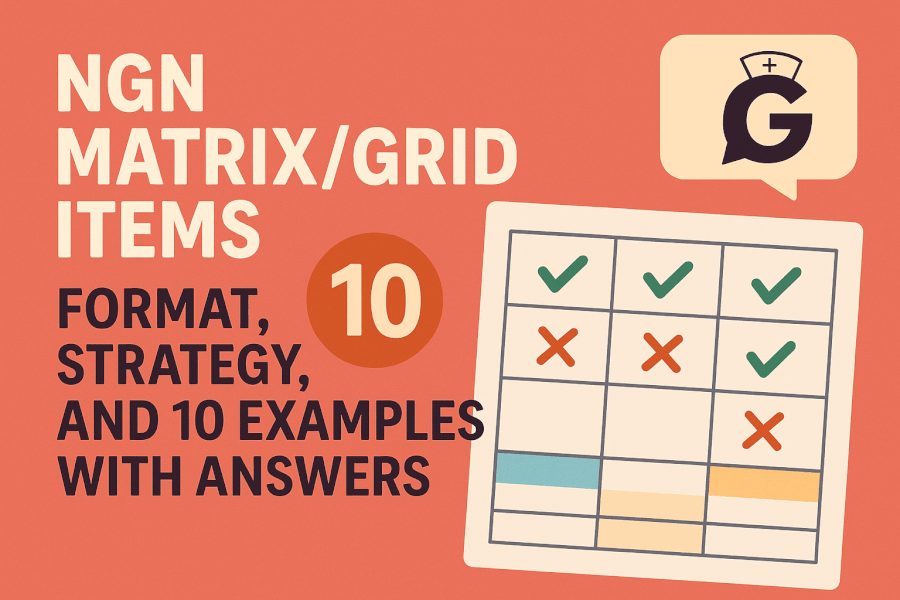Matrix/grid items ask you to evaluate multiple pieces of data at once and make several decisions on the same screen. You’ll mark which cues are relevant, match interventions to problems, or select the best rationales—often across columns and rows. After two decades in practice and a decade teaching/tutoring, I can tell you: candidates who slow down to name the priority and then select only the few truly relevant options do best on these.
Table of Contents
- What Matrix/Grid Items Are
- How Scoring Works (Partial Credit)
- A Repeatable Strategy You Can Trust
- Common Traps to Avoid
- Time Management & Pacing
- 10 Practice Matrix/Grid Examples (with Answers)
- FAQs
- Further Reading
🎯 Free NCLEX quiz!
Test your knowledge—new quizzes added weekly!
What Matrix/Grid Items Are
A matrix/grid screen typically shows a case stem with evolving data and a table where you’ll:
- Mark relevant vs. not relevant cues,
- Match problems ↔ actions ↔ rationales across columns,
- Or check all that apply in each row.
Unlike single best-answer items, matrix/grid requires pattern recognition and prioritization across several micro-questions. If matrix feels abstract, start from the priority: What’s most likely and most dangerous here? Once you’ve named it, most correct selections become obvious.
Faculty tip: If you haven’t read it yet, my primer on reading stems efficiently is here:
https://goodnurse.com/article/191/how-to-read-ngn-case-stems-2025-clinical-judgment-strategy-guide
How Scoring Works (Partial Credit)
NGN uses partial credit. That means you can still earn points by selecting the most relevant items even if you miss one. However, indiscriminately clicking too many boxes can subtract credit in formats that penalize over-selection.
- Relevant/Not Relevant grids: Earn credit for correct markings; excessive wrong selections reduce your net.
- Match/matrix (actions, rationales): Credit for each correct alignment; unrelated picks can lower score.
- Clinical safety bias: Items tied to safety (airway, perfusion, high-alert meds) often carry more weight.
Faculty tip: On matrix, quality beats quantity. If an option doesn’t move the clinical needle, skip it.
A Repeatable Strategy You Can Trust
Use this method every time. It aligns 1:1 with the NGN clinical judgment model and keeps you from over-clicking.
- Time & trend first. Is the client worsening? Post-op? Post-medication? Trends change priority.
- Name the problem in one line. “Likely sepsis with hypoperfusion,” or “Hypoventilation from opioid.”
- Select only cues that support the priority. High-yield signs go in; normal/background noise stays out.
- Choose nursing actions for the priority. Least invasive, safest, most effective you can do now.
- Choose monitoring parameters that prove success/failure. Pick what you’ll reassess in 10–30 minutes.
- Sanity check. Would a preceptor nod at your choices? If an option is routine but not priority-driven, leave it.
For category context and weighting, keep this reference handy:
And if the scenario involves physiologic instability, these core rules help:
Common Traps to Avoid
- Cue hoarding: Don’t mark every abnormal. Choose only the ones tied to your priority hypothesis.
- Provider-first reflex: Stabilize with nursing actions you can implement, then escalate.
- Normal values in context: A “normalish” number can be concerning given the trend (e.g., SpO₂ 92% with rising RR).
- Medication tunnel vision: High-alert meds change priorities. Recognize opioid sedation, insulin timing, anticoagulation risks.
- Overmatching: In match grids, if the rationale doesn’t clearly explain why an action works for this problem, skip it.
Faculty tip: If you’re torn between two plausible actions, pick the one that fixes the physiology first (airway/oxygenation, perfusion), then the preventive/diagnostic step.
Time Management & Pacing
- Macro pace: About 2 minutes per interaction on matrix/grid.
- Micro cycle: Read stem (25–30 s) → name priority (10 s) → pick 3–5 high-yield selections (60–70 s) → sanity check (10–15 s).
- Flag & move: If you hit three minutes, commit to your best clinical reasoning and proceed—partial credit is your friend.
Want a full study plan so NGN practice doesn’t crowd out other content? See:
https://goodnurse.com/article/45/how-long-should-i-study-for-the-nclex
10 Practice Matrix/Grid Examples (with Answers)
Below are condensed practice matrices you can walk through. I recommend covering the right column, making your selections, then checking the key.
1) Post-op hypoventilation (opioid)
Stem highlights: 64-yo 30 min after morphine, RR 10, shallow breaths, SpO₂ 88% RA, drowsy.
Relevant cues (select): Recent opioid; low SpO₂; shallow respirations; drowsiness.
Actions (select): Elevate HOB; apply O₂ per protocol; encourage deep breathing/incentive spirometry.
Rationales (match): Improve oxygenation; counteract hypoventilation; reduce sedation risk by non-drug steps first.
Monitor: SpO₂; RR; sedation score.
For a bow-tie version of this pattern, see: https://goodnurse.com/article/192/ngn-bow-tie-items-2025-format-strategy-and-10-examples-with-answers
2) Early sepsis from UTI (older adult)
Cues: Temp 39.1 °C, HR 118, BP 94/56, confused; suspected infection.
Select cues: Fever, hypotension, tachycardia, new confusion.
Actions: Start IV fluids per order; obtain cultures and begin antibiotics per order; trend MAP.
Rationales: Restore perfusion; treat source; monitor hemodynamic response.
Monitor: MAP/BP; urine output; mentation.
3) DKA vs. HHS differentiation
Stem: 22-yo T1DM, glucose 520, fruity breath, Kussmaul respirations, abd pain; labs pending.
Select cues: Kussmaul respirations; fruity breath; younger age; likely metabolic acidosis.
Actions: Start IV fluids per order; initiate insulin infusion per protocol; monitor potassium.
Rationales: Correct dehydration; reduce ketogenesis; prevent hypokalemia due to insulin shift.
Monitor: BMP (K⁺, bicarbonate); anion gap; glucose.
4) Hyperkalemia on telemetry (CKD)
Cues: K⁺ 6.3 mEq/L, peaked T-waves, bradycardia, CKD.
Actions: Continuous cardiac monitoring; administer insulin with dextrose per order; prepare calcium gluconate if instability.
Rationales: Reduce arrhythmia risk; shift K⁺ intracellularly; stabilize myocardium if needed.
Monitor: Rhythm; K⁺; symptoms.
5) COPD CO₂ retention vs. hypoxia
Cues: Dyspnea, drowsy, RR 10, SpO₂ 90% on 2 L, shallow breathing.
Actions: Elevate HOB; pursed-lip breathing; cautious O₂ titration per protocol; assess for CO₂ narcosis.
Monitor: SpO₂; RR; level of consciousness; ABG if ordered.
Rationale match: Improve ventilation, avoid suppressing hypoxic drive while treating hypoxia.
6) Suspected PE (DVT history)
Cues: Sudden pleuritic chest pain, tachycardia, SpO₂ 88% RA.
Actions: Apply oxygen; minimize activity; prepare for imaging and anticoagulation per orders.
Monitor: SpO₂; RR/HR; signs of hemodynamic compromise.
Rationale: Support oxygenation and prevent embolus migration while definitive therapy is arranged.
7) Postpartum atony/hemorrhage
Cues: Boggy fundus, heavy lochia, BP trending down.
Actions: Fundal massage; ensure IV access; notify provider/prepare uterotonics per orders.
Monitor: Bleeding amount; BP/HR; uterine tone.
Rationale: Restore tone and perfusion; expedite pharmacologic control.
8) Pediatric dehydration (AGE)
Cues: Lethargy, dry mucosa, cap refill > 3 s, ↓ UOP.
Actions: Isotonic IV fluids per order; strict I&O; oral rehydration as tolerated.
Monitor: Urine output; capillary refill; HR.
Rationale: Rapid volume restoration and monitoring for response.
9) Digoxin toxicity risk (hypokalemia)
Cues: N/V, yellow vision halos, irregular pulse; on digoxin; K⁺ 3.1.
Actions: Hold digoxin; obtain dig level/EKG; replace potassium per order.
Monitor: Rhythm; K⁺; digoxin level; symptoms.
Rationale: Reduce toxicity risk and correct precipitating electrolyte imbalance.
10) Anaphylaxis after first antibiotic dose
Cues: Wheezing, urticaria, hypotension minutes after infusion start.
Actions: Stop infusion; administer epinephrine per protocol; high-flow O₂; prepare for IV fluids.
Monitor: Airway/SpO₂; BP/HR.
Rationale: Rapid reversal of airway/perfusion compromise.
Faculty tip: If you can explain your grid out loud—“These cues prove sepsis; I’ll give fluids and start antibiotics per order; I’ll watch MAP and UOP”—you’re ready for NGN clinical judgment.
FAQs
How many boxes should I click on a matrix?
As few as necessary. Select the key cues/actions that support the priority. Over-selection can reduce credit.
What if two actions seem reasonable?
Pick the action that best addresses the highest-priority physiologic need and is safe to implement now.
Do I always need numeric parameters?
Commonly yes (SpO₂, MAP, UOP), but mental status and pain scale are valid if they reflect your intervention’s effect.
How can I get faster without losing accuracy?
Use a micro routine: priority → 3–5 high-yield selections → sanity check. Practice short, daily sets to build speed.
Where should I start if matrix items overwhelm me?
Start with stem reading skills and bow-tie structure, then move to matrix:
- https://goodnurse.com/article/191/how-to-read-ngn-case-stems-2025-clinical-judgment-strategy-guide
- https://goodnurse.com/article/192/ngn-bow-tie-items-2025-format-strategy-and-10-examples-with-answers







